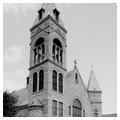A salient component of Charleston's ecclesiastical center, Sacred Heart is a bold Richardsonian Romanesque structure. Its Kentucky
Inside, the broad nave, barely perceptible transepts, and shallow chancel seem more akin to a Protestant auditorium than to a Catholic sanctuary. Three large stained glass windows imported from Germany depict the Nativity, Last Supper, and Ascension of the Virgin. The Riordan Company of Cincinnati fabricated the smaller windows that show various saints and church fathers. Parochial buildings flank the church, and the Tudor Revival Charleston Catholic High School, dating from 1940, is across Virginia Street. A co-cathedral, Sacred Heart shares honors with St. Joseph Cathedral ( WH12) as the seat of the Bishop of the Roman Catholic Diocese of Wheeling-Charleston.












